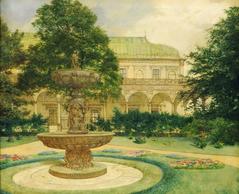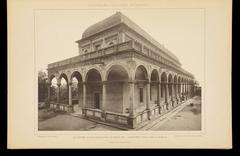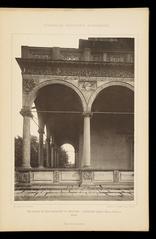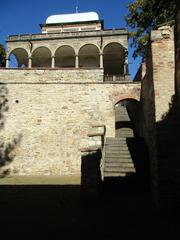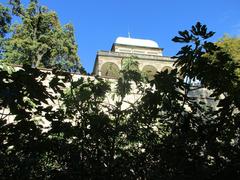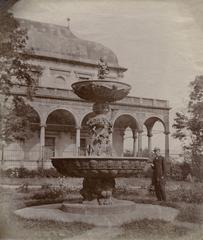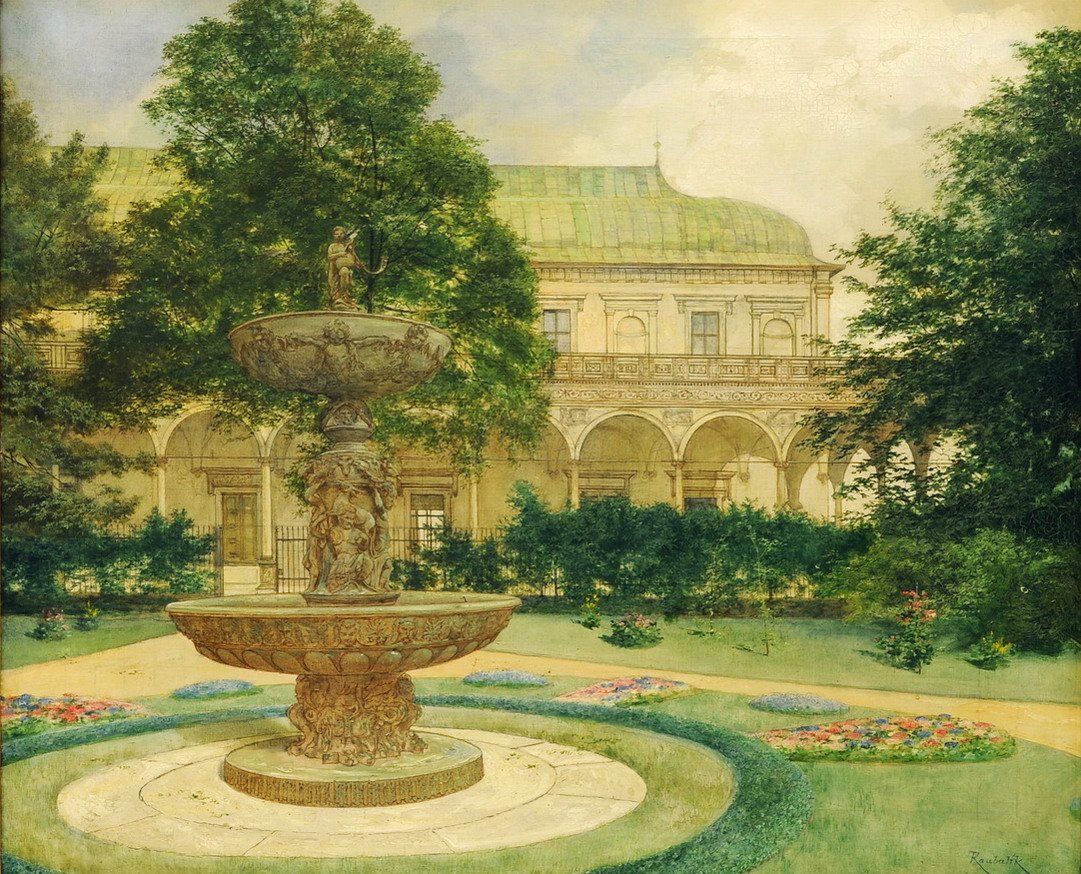
Queen Anne Summer Palace Prague: Visiting Hours, Tickets, and Historical Sites Guide
Date: 14/06/2025
Introduction
Queen Anne’s Summer Palace (Letohrádek královny Anny), known as the Belvedere, stands as an architectural jewel of the Prague Castle complex and a premier example of Italian Renaissance design in Central Europe. Commissioned in 1538 by Emperor Ferdinand I for his wife, Queen Anne of Bohemia and Hungary, this palace is celebrated for its elegant arcades, richly sculpted reliefs, and the enchanting Singing Fountain. Over the centuries, it has served as an imperial pleasure retreat, a center for scientific discovery, and a dynamic cultural venue hosting renowned exhibitions and festivals. This detailed guide covers the palace’s history, architectural features, visitor information, ticketing, nearby attractions, and practical tips to help you plan an unforgettable visit. For updates and further details, consult the official Prague Castle website and trusted resources like Prague Vitruvius and Designblok.
Table of Contents
- Introduction
- Historical Overview
- Artistic and Decorative Features
- The Singing Fountain
- Visitor Information
- Location and Access
- Facilities and Visitor Support
- Events and Special Programs
- Frequently Asked Questions (FAQ)
- Conclusion & Final Tips
- References and Links
Historical Overview
Origins and Construction
Queen Anne’s Summer Palace was commissioned by Emperor Ferdinand I in 1538 as a grand gesture to his wife, Queen Anne. Italian architect Paolo della Stella designed the palace, with construction managed by Giovanni Spatio. Although Queen Anne passed away before its completion in 1547, the palace—completed in 1560—stands as a testament to Renaissance artistry and imperial devotion (Prague Vitruvius; Avantgarde Prague).
Architectural Significance
The palace is widely recognized as one of the purest and earliest examples of Italian Renaissance architecture north of the Alps. Its rectangular plan is enveloped by arcaded loggias, supported by 36 Ionic columns with beautifully sculpted capitals. The upper floor, added by Hans Tirole and Bonifaz Wohlmut, houses a grand gallery beneath a unique copper roof shaped like an inverted ship’s keel—a marvel of Renaissance engineering (Prague Vitruvius; Avantgarde Prague).
Notable Historical Events
Rudolf II and the Age of Science
Under Emperor Rudolf II (1576–1612), the palace was transformed into an astronomical observatory and a center for the sciences, attracting luminaries such as Tycho Brahe and Johannes Kepler. It also served as a repository for part of Rudolf’s extensive art collection (Prague.net).
The Thirty Years’ War
In 1648, Swedish troops looted the palace during the Thirty Years’ War, taking valuable artworks and scientific instruments. This event marked a period of decline and neglect for the palace.
Preservation and Modern Use
Recognized for its cultural significance, the palace became a national monument in 1962. Restoration campaigns in the 19th and 20th centuries preserved its architectural and artistic integrity. Today, it hosts art exhibitions, cultural festivals, and design events, notably partnering with Designblok for contemporary showcases (Wikipedia).
Artistic and Decorative Features
The palace’s façade and interiors are adorned with 114 reliefs depicting mythological, allegorical, and courtly scenes, as well as an 80-centimeter-high ornamental frieze encircling the structure. These details reflect Renaissance ideals and the Habsburg dynasty’s cultural aspirations (Avantgarde Prague).
The Singing Fountain
Installed in 1558, the Singing Fountain is a Renaissance masterpiece cast from bell bronze by Tomáš Jaroš. Its design features hunting motifs, masks, and mythological figures. The fountain produces melodic sounds as water strikes the bronze basin, enchanting visitors for centuries (Grumpy Camel).
Visitor Information
Visiting Hours
- April – October: 9:00 AM – 6:00 PM (Tuesday–Sunday)
- November – March: 10:00 AM – 4:00 PM (Tuesday–Sunday)
- Monday: Closed (except public holidays)
- Special Events: Hours may be extended during festivals such as Designblok.
Check current schedules on the official Prague Castle website.
Tickets and Admission
- Standard Admission: 250 CZK (adults), 150 CZK (students, seniors), free for children under 6
- Combined Tickets: Available for multiple Prague Castle sites
- Special Exhibitions: May require separate tickets or surcharges
- Tickets are available online or at the entrance (Prague.net; Your City Visit).
Accessibility
- Partial Wheelchair Access: Main entrance and ground floor accessible; upper floors require stairs
- Assistance: Available upon request; contact visitor center in advance (Prague Castle accessibility guide)
Guided Tours & Travel Tips
- Guided Tours: Offered in several languages and recommended for historical context
- Best Time to Visit: Early mornings or late afternoons on weekdays
- Photography: Non-commercial photography is allowed; permits may be required for professional equipment
Nearby Attractions
- Within Prague Castle: St. Vitus Cathedral, Old Royal Palace, Golden Lane, Lobkowicz Palace Museum
- Royal Gardens: Formal Renaissance gardens, botanical specimens, and panoramic city views
- Letná Park & Malá Strana: Additional nearby attractions with scenic walks and cafés
Location and Access
- Address: U Prašného mostu 52/12, 118 00 Praha 1-Hradčany, Czech Republic
- By Public Transport: Tram lines 22 or 23 to “Královský letohrádek” or metro Line A to “Malostranská” plus a scenic walk
- On Foot: Easily reached from central Prague landmarks via the Royal Gardens
- By Car: Limited parking; use public transport if possible (Prague public transport)
Facilities and Visitor Support
- Restrooms: Available near the palace and throughout the castle complex
- Refreshments: No café inside the palace; several options nearby
- Gift Shops: Operate during major exhibitions
- Seating: Benches in gardens and arcades
- Security: Security checks at all castle entrances; allow extra time
Events and Special Programs
- Exhibitions: Rotating displays of art, design, and Bohemian history
- Designblok: Central Europe’s largest design and fashion festival, featuring cutting-edge exhibitions and installations (Designblok)
- Concerts & Lectures: Hosted during summer and cultural festivals
- Educational Programs: Workshops and tours for schools and families
Frequently Asked Questions (FAQ)
Q: Where can I buy tickets for Queen Anne’s Summer Palace?
A: Tickets are available at Prague Castle ticket offices and online (Prague Castle website).
Q: What are the palace’s visiting hours?
A: Typically 9:00 AM–6:00 PM (April–October), 10:00 AM–4:00 PM (November–March). Closed Mondays.
Q: Is the palace accessible to visitors with mobility impairments?
A: The ground floor is accessible; upper levels may require stairs. Gardens have paved but sometimes uneven paths.
Q: Are guided tours available?
A: Yes, in multiple languages. Book in advance or inquire at the ticket office.
Q: Can I take photos inside the palace?
A: Non-commercial photography is allowed; professional equipment may need permission.
Conclusion & Final Tips
Queen Anne’s Summer Palace is a remarkable fusion of Renaissance elegance, artistic achievement, and dynamic cultural life. From its origins as an imperial gift to its current role as a hub for art and design, it remains a highlight of Prague’s heritage. Plan your visit around seasonal opening hours, book tickets in advance, and explore nearby attractions to fully experience the richness of the Prague Castle complex. For up-to-date information, download the Audiala app, follow us on social media, and consult the official Prague Castle website.
References and External Links
- Prague Vitruvius
- Avantgarde Prague
- Designblok
- Your City Visit
- Wikipedia
- Prague Castle Official Website
- Prague.net
- Grumpy Camel Prague Castle Guide
- View from Prague
- Prague public transport
